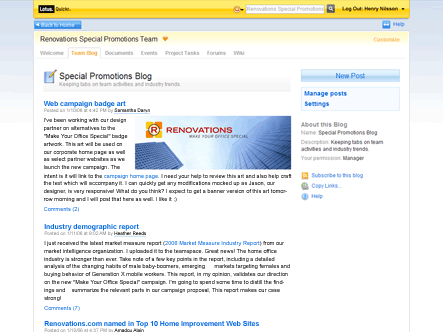 Prior to attending the Lotus Collaboration Summit earlier in September 2007, I committed to report on my findings re: Quickr.
Prior to attending the Lotus Collaboration Summit earlier in September 2007, I committed to report on my findings re: Quickr.
Well, Quickr is a polished powerful mashup-capable ad hoc collaboration tool for geographically disperse and cross-functional work project teams in medium and large organizations. Having worked while at 3Com with earlier (and less functional) versions of this functionality, and worked with other collaboration or knowledge-transfer problems common in large organizations, I have some context for reviewing Quickr that may be stronger than others.
At 3Com, we used Notes and various 'databases' to allow a group of product marketers for diverse products – switches, routers, wireless, VoIP – to post, edit, repost revisions of their PowerPoint content designed for presentation at various sales training or reseller training events. These product marketers often were assigned as pairs – one in market and one in corporate – and so the chart review process meant considerable time-shifting: you edit convenient to you and post so that I can edit in my timezone reposting the next revision.
At it's most base level, this technique worked. Problems were that the technical skill required to post or even find the 'database' where the content existed were often beyond most casual users, so there were still plenty of emailing around. The advantage of the implementation was the reduced email volumes, reduced storage (since a ppt was replicated in each client and each server account), and gave the overall project manager the ability to monitor progress and call out laggards or high performers.
At Nortel eBusiness Solutions (Nortel owned Clarify in 2000 and early 2001), the problem was in getting precise product marketing content into the hands of the sames team – a dynamic, constantly changing critical resource. Here we used collaboration techniques embedded in a hosted service called Ventasso. This content management system enforced a discipline that allowed marketers to get their point across to a sales person viewing a browser. Automation helped generate specific competitive profiles, sales tips and select reference accounts that would be appropriate. I called it our 'Marketing Multiplier' since it amplified the marketer's insights.
 The demo of Quickr presented at the Summit was very dynamic and not unlike the content management system used to develop this site, but with more commercially important features such as user selectable templates for layout, security defining who has what privileges, features for wiki, blog, knowledge-base and a growing connector library into other content repositories including the IBM FileNet system.
The demo of Quickr presented at the Summit was very dynamic and not unlike the content management system used to develop this site, but with more commercially important features such as user selectable templates for layout, security defining who has what privileges, features for wiki, blog, knowledge-base and a growing connector library into other content repositories including the IBM FileNet system.
IBM claims that Quickr is the first web 2.0 commercial-grade solution and I believe them, although the 'commercial-grade' is not such a big deal anymore. Support services, integration with other collaboration services like calendaring and persistent instant messaging are key.
From my vantage point, Quickr offers a scope of functionality and feature set that is a powerful step up from the single-purpose toolkits of earlier revs (3Com) or the clumsy hosted offerings of pre-open source industry-specific applications (Nortel). As well, its simple administration for the project leader make it a very compelling offer compared to several open source projects. The big issue for IBM is how to facilitate the migration?
It would seem to me that many organizations have deployed web 2.0 functionality using less elegant tools and effecting the transition of the infrastructure (there is no client per se) is really the lion's share of the transition. All in favor of migrating databases raise your hand? This is a mighty big hurdle to the success of this offering.









